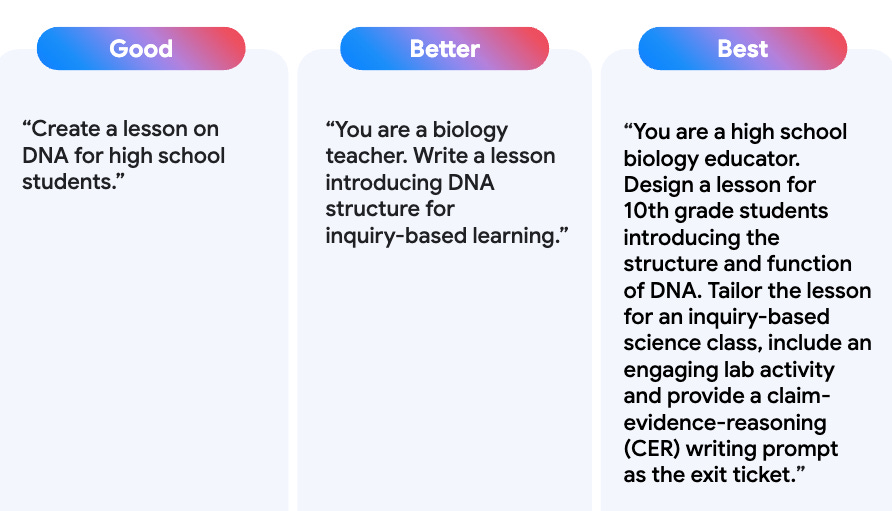PARTS in Prompts
This blog is about helping everybody learn better, or that, at any rate, is the plan.
So if you're at home, hoping to help your child learn a topic better by using all these awesome new AI tool thingummies, how do you get your child to learn about, say DNA?
Google gives you three example prompts, shown above, and tells you that the one on the left is good, the one in the middle is better, and the one at the right is best.
But why?
Why is the leftmost prompt just about ok, and the one at the right by far and away the best?
Because anytime you write a prompt, and especially one that is designed to help you learn, you need to think about three four things you should definitely be including in the prompt.
Who is the audience?
Who is the lecturer?
What do you want to learn about?
How do you want to go about learning it?
Google calls this the PARTS structure:
And sure, call it PARTS, or whatever you like. But when writing your prompt, do think carefully about your answers to the four questions listed above:
Who is going to be reading the output from Gemini, or ChatGPT or whichever other LLM you are using? Is it you, or your kid? Should the explanation be written at a level that you will be fine with? Or at a level that your kid will be fine with?
What role do you want the LLM to adapt? Should the LLM pretend to be a patient, slightly humorous high-school teacher? Or would you like the lecture to be in the style of Grant Sanderson? Or maybe the answer should be written in the style of a Coldplay song? There will be tradeoffs, especially with that last bit, but hey, feel free to experiment, and settle on a style that works for your intended audience. Or a set of styles, of course! It is perfectly fine to say that you should give two explanations: one in the style of a patient, kind indulgent grandmother, and another in the style of a song from Frozen. And again, customize this as per your preferences, please!
What do you want to learn about? I mean, DNA, sure, but what about DNA? Its importance in our bodies? How it was discovered? Its chemical make-up? Cutting edge research about DNA that can be understood by a high-school student? Something else? The more specific you are, the better the answer will be.
How do you want to go about learning about this topic? Should it create a chapter outline suitable for a 7th grader? Or how about a series of slides? A twenty bullet point summary? A trip into DNA land with Neil DeGrasse Tyson? That last one may run into some issues (perhaps), so feel free to use proxies that are close enough to the persona you want. But again, your only constraint is how imaginative you are.
Here's Google's own example of a very good prompt that takes into account the answers to all four of my questions, or the PARTS framework:
You are a high school biology educator. Design a lesson for 10th
grade students introducing the structure and function of DNA.
Tailor the lesson for an inquiry-based science class, and include an
engaging lab activity and a claim-evidence-reasoning (CER) writing
prompt as the exit ticket.
The most important additions I would recommend are further customization and localization, if you were looking for ways to make this even better. "You are a high school biology educator based out of India", for example. "Design a lesson for a 10th grade student who is interested in playing basketball", because why not? Or whatever else you think is going to be applicable, and will make learning more fun.
As with cooking, so also with prompts - you will learn that a little restraint with the additions goes a very long way.
But the next time you plan on using your friendly neighborhood LLM as a way to help folks learn better, do check if you have thought about the four questions in your prompt:
Who, exactly, is learning?
Who, exactly, is teaching?
What do you want to learn? Give lots of details!
How do you want to learn it? Ditto!



